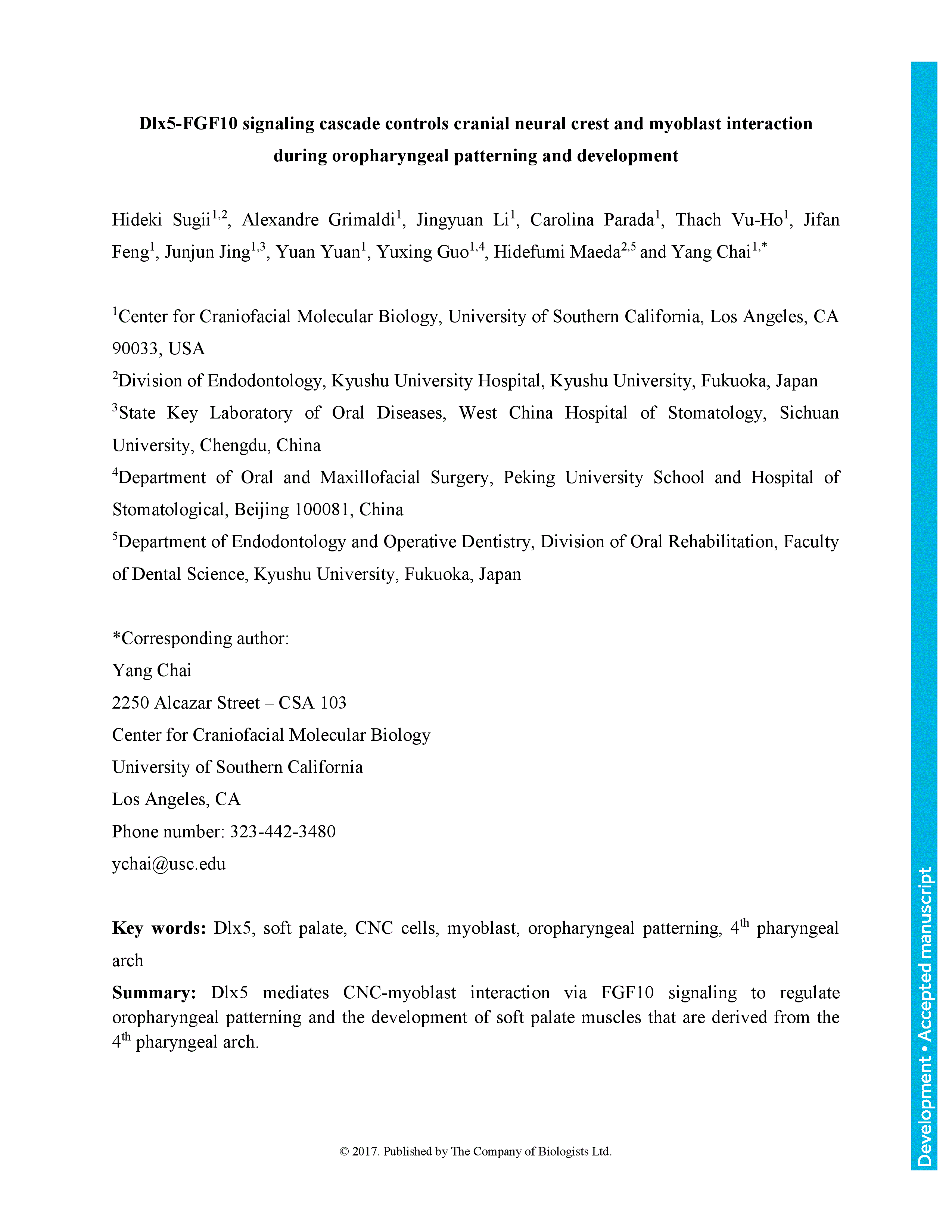Craniofacial development depends on cell-cell interactions, coordinated cellular movement and differentiation under the control of regulatory gene networks, which include the distal-less (Dlx) gene family. However, the functional significance of Dlx5 in patterning the oropharyngeal region has remained unknown. Here we show that loss of Dlx5 leads to a shortened soft palate and an absence of the levator veli palatini, palatopharyngeus, and palatoglossus muscles that are derived from the 4th pharyngeal arch (PA), but the tensor veli palatini, derived from the 1st PA, is unaffected. Dlx5-positive cranial neural crest (CNC) cells are in direct contact with myoblasts derived from the pharyngeal mesoderm, and Dlx5 disruption leads to altered proliferation and apoptosis of CNC and muscle progenitor cells. Moreover, the FGF10 pathway is downregulated in Dlx5-/- mice, and activation of FGF10 signaling rescues CNC cell proliferation and myogenic differentiation in these mutant mice. Collectively, our results indicate that Dlx5 plays critical roles in patterning of the oropharyngeal region and development of muscles derived from the 4th PA mesoderm in the soft palate, likely via interactions between CNC-derived and myogenic progenitor cells.
Dlx5-FGF10 signaling cascade controls cranial neural crest and myoblast interaction during oropharyngeal patterning and development
Currently Viewing Accepted Manuscript - Newer Version Available
Hideki Sugii, Alexandre Grimaldi, Jingyuan Li, Carolina Parada, Thach Vu-Ho, Jifan Feng, Junjun Jing, Yuan Yuan, Yuxing Guo, Hidefumi Maeda, Yang Chai; Dlx5-FGF10 signaling cascade controls cranial neural crest and myoblast interaction during oropharyngeal patterning and development. Development 2017; dev.155176. doi: https://doi.org/10.1242/dev.155176
Download citation file:
Advertisement
Call for papers: Uncovering Developmental Diversity

Development invites you to submit your latest research to our upcoming special issue: Uncovering Developmental Diversity. This issue will be coordinated by our academic Editor Cassandra Extavour (Harvard University, USA) alongside two Guest Editors: Liam Dolan (Gregor Mendel Institute of Molecular Plant Biology, Austria) and Karen Sears (University of California Los Angeles, USA).
Choose Development in 2024

In this Editorial, Development Editor-in-Chief James Briscoe and Executive Editor Katherine Brown explain how you support your community by publishing in Development and how the journal champions serious science, community connections and progressive publishing.
Journal Meeting: From Stem Cells to Human Development

Register now for the 2024 Development Journal Meeting From Stem Cells to Human Development. Early-bird registration deadline: 3 May. Abstract submission deadline: 21 June.
Pluripotency of a founding field: rebranding developmental biology

This collaborative Perspective, the result of a workshop held in 2023, proposes a set of community actions to increase the visibility of the developmental biology field. The authors make recommendations for new funding streams, frameworks for collaborations and mechanisms by which members of the community can promote themselves and their research.
Read & Publish Open Access publishing: what authors say

We have had great feedback from authors who have benefitted from our Read & Publish agreement with their institution and have been able to publish Open Access with us without paying an APC. Read what they had to say.



